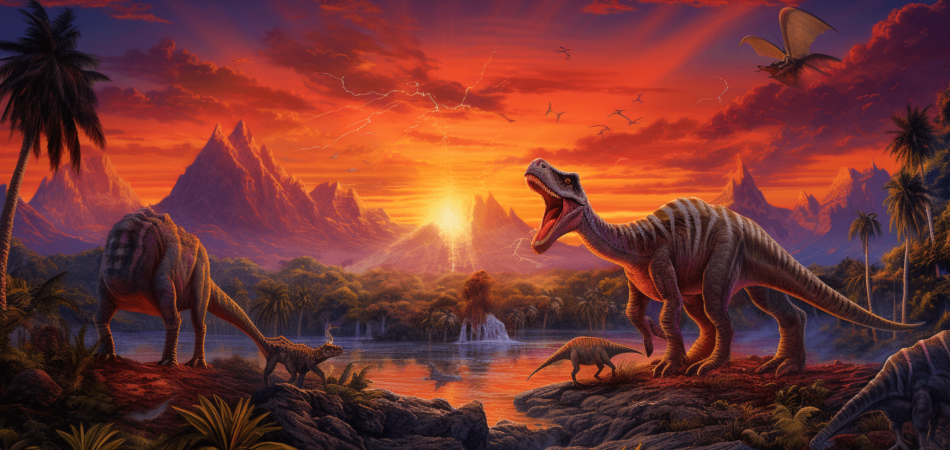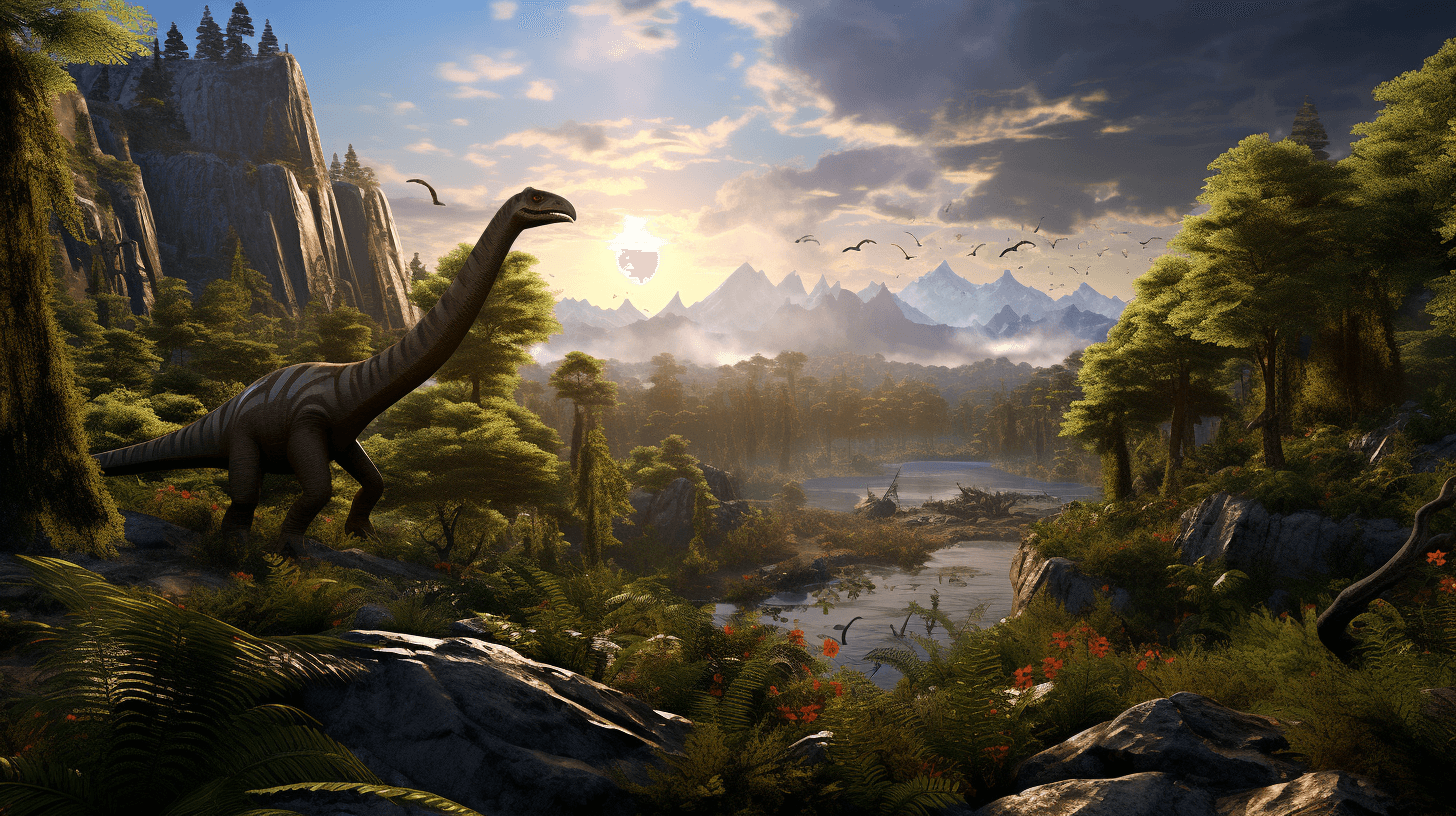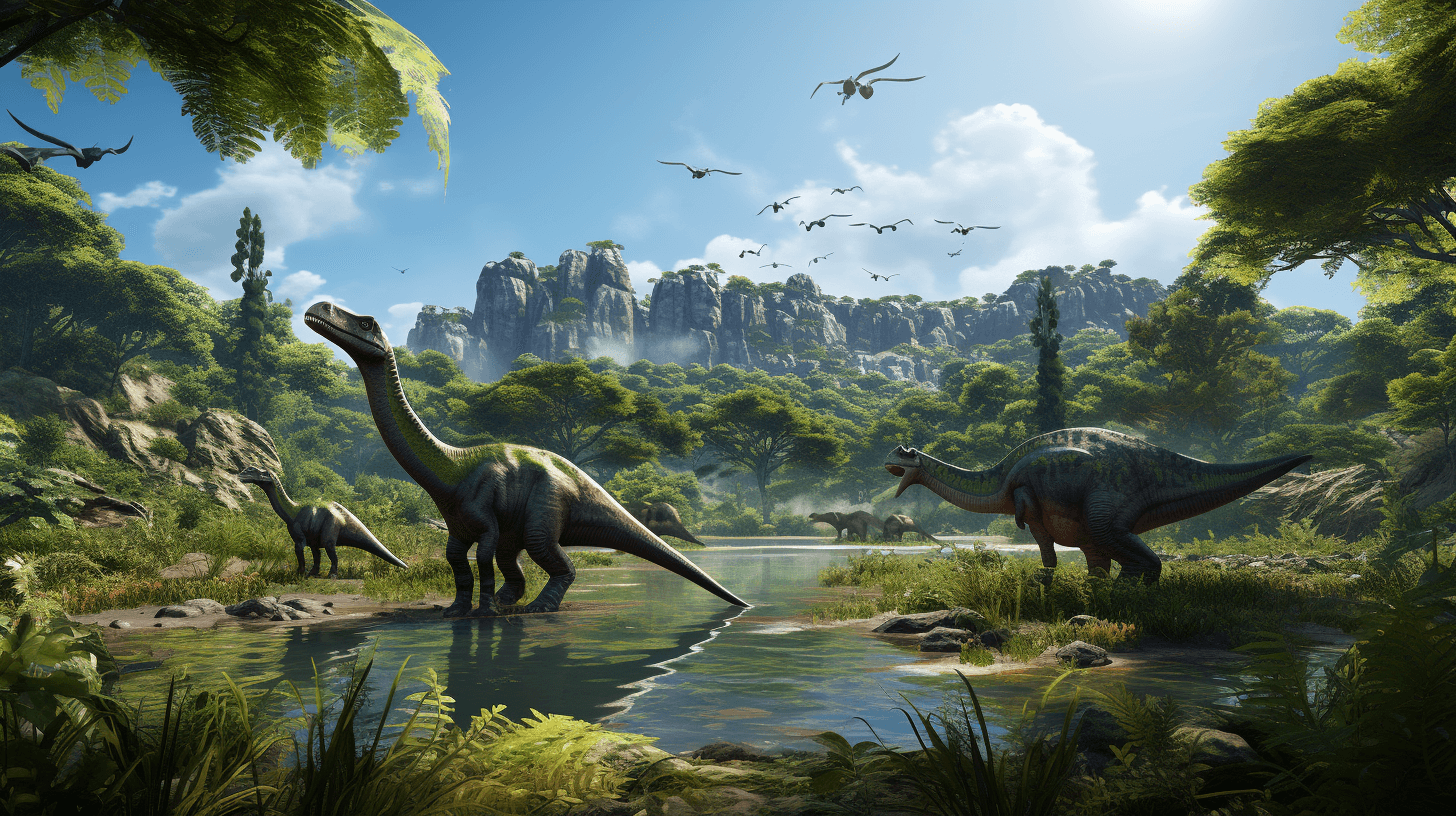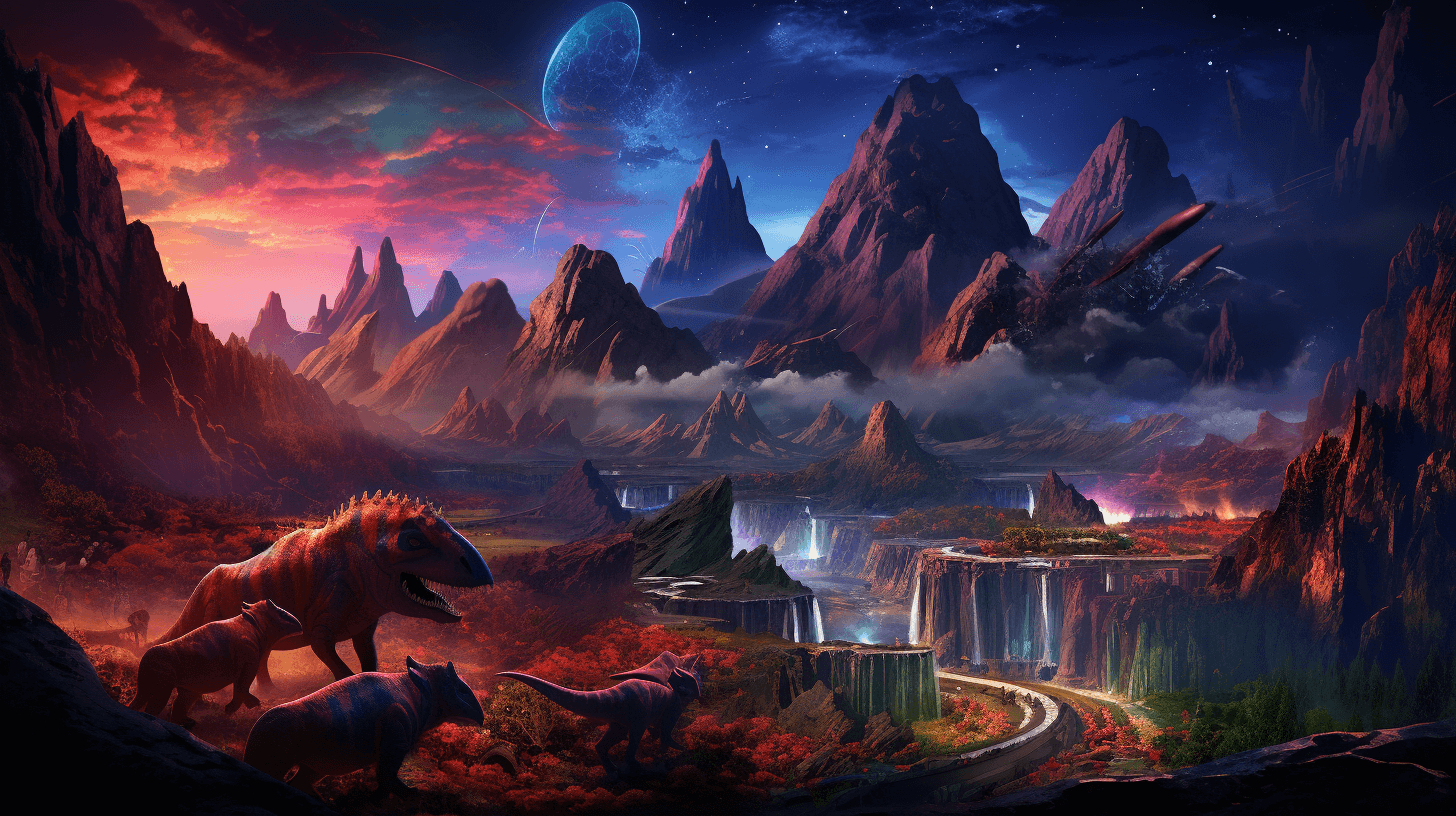Aardonyx Guide:
Aardonyx was an early dinosaur that lived in South Africa about 200 million years ago.
Aardonyx was an early dinosaur that lived in South Africa about 200 million years ago.

Imagine you’re stepping back over 250 million years into the Triassic Period, where life’s rebounding after a massive extinction. You’d witness the birth of dinosaurs, the rule of archosaurs, and the first mammals.
You’re about to explore a world dominated by the supercontinent Pangea, under an unforgiving hot, dry climate. It’s a journey that’ll leave you amazed at how life thrived amidst such challenging times.

You’re about to delve into the fascinating world of the Permian-Triassic extinction event. Here, you’ll encounter various theories explaining this cataclysmic event.
You’ll explore the unique differences in Pangea’s flora, shedding light on how plant life varied across this ancient supercontinent.
It’s still a mystery what exactly caused the Permian-Triassic extinction event, but theories range from asteroid impacts and volcanic eruptions to methane release, sea level changes, and increasing dryness. As you dive into this topic, you might ask, are alligators descendants of dinosaurs? Or did alligators evolve from dinosaurs?
Now, let’s transition into understanding the differences in Pangea’s flora during the Triassic period.
Conifers, towering up to 30 meters tall, dominated the landscape of Pangea, marking a stark contrast in flora across the northern and southern parts of this vast supercontinent. This difference can be seen in the types of species that thrived in each area.
You might be wondering about the connection between alligators and dinosaurs in this context. Well, here’s the deal:
Understanding these relationships gives us a better picture of life on Pangea.
Now, let’s delve into the intriguing topic of post-extinction ecosystem recovery.
Post-extinction, the slow re-establishment of various plants marked the start of ecosystem recovery. This gradual process paved the way for the resurgence of diverse fauna, including the ancestors of today’s alligators.
You might wonder, ‘Are alligators descended from dinosaurs?’ The answer isn’t direct. Alligators, dinosaurs, and birds are all part of a group called Archosaurs. However, alligators didn’t evolve from dinosaurs. Instead, they share a common ancestor. The nearest living relatives of crocodiles and alligators are birds, not dinosaurs.
Birds and crocodiles last shared a common ancestor around 240 million years ago. This deep dive into the resurgence of life post-extinction sets the stage for a closer look at the shift in dominance and ecosystem re-establishment in the Triassic period.

In exploring the Triassic Period, you’re about to delve into a fascinating shift in dominance among species and the intricate process of ecosystem re-establishment following the Permian-Triassic Extinction.
You’ll observe the intriguing transition from the rule of mammal-like reptiles to the emergence of archosaurs, which encapsulates dinosaurs and birds, by the end of the Middle Triassic.
More than just a timeline, it’s a complex interplay of competition, adaptation, and evolutionary innovation that reshapes our understanding of life’s resilience in the face of catastrophic changes.
During the early Triassic, mammal-like reptiles were the dominant species. However, by the end of the Middle Triassic, archosaurs, including dinosaurs and birds, began to take over. It’s fascinating to consider these evolutionary shifts.
Now, you may wonder, “Are alligators related to dinosaurs?” and “Are crocodiles and alligators related to dinosaurs?”
Yes, alligators and crocodiles are related to dinosaurs. They’re all part of the group called archosaurs.
The closest relative to the dinosaur is the modern bird, tracing back to a common ancestor.
Birds and dinosaurs share a specific ancestor species, which is different from the one shared by alligators and crocodiles.
As we move forward, we’ll delve into how these major shifts affected the re-establishment of ecosystems during this compelling period.
It’s intriguing to delve into how ecosystems began to rebuild after such a catastrophic extinction event.
You might wonder, is an alligator a dinosaur? Or, were alligators dinosaurs? Well, alligators are not considered dinosaurs, but they do share a common ancestry. They belong to a group known as archosaurs, which includes dinosaurs and birds. In fact, alligators and crocodiles are considered living fossils as they’ve remained virtually unchanged for millions of years.
After the extinction event, these resilient creatures played a vital role in the re-establishment of ecosystems during the Triassic period.
Now, let’s move forward and delve into the fascinating variety of archosaurs that roamed the Earth in the Triassic period.

You’re about to delve into the intriguing world of the Triassic period’s archosaurs, exploring the pivotal shift in dominance that allowed these creatures to rule the landscape.
You’ll discover the fascinating diversity among archosaur species, from the towering dinosaurs to the early ancestors of modern birds.
As you examine the details of this evolutionary transition, you’ll gain a deeper understanding of how these dominant species adapted to their environment and carved their place in history.
Archosaurs began to dominate by the end of the Middle Triassic. This was largely due to their ability to fill empty niches left by synapsid extinctions.
You may be wondering, ‘is an alligator a dinosaur?’ In fact, alligators are archosaurs, just like dinosaurs, but they’re not dinosaurs themselves. The alligator vs dinosaur debate highlights the evolutionary paths these creatures took. Alligators are related to dinosaurs, but they’re more closely related to birds.
The archosaurs dominance shift was a pivotal moment in Triassic history. It marked the rise of the dinosaurs and alligators we’re familiar with today. This shift not only shaped the ecosystem, but it also set the stage for the emergence of diverse archosaur species.
Next, let’s dive into the emergence of these diverse archosaur species.
Diverse species of archosaurs began to emerge during the Triassic period, displaying a variety of adaptations and evolving into forms both familiar and bizarre.
Among these, you might ask, ‘are alligators dinosaurs?’ Though closely related, alligators are not dinosaurs but belong to a group known as crocodylomorphs.
As we continue to delve into the fascinating world of the Triassic period, we’ll explore the crucial role dinosaurs played in this era’s biodiversity.

You’re about to delve into a fascinating exploration of the Triassic Period. We’ll particularly focus on the initial appearance of dinosaurs and their subsequent impact on ecosystem dynamics.
This era marks the first record of dinosaurs. They were small bipedal creatures inhabiting various environments of the supercontinent, Pangea.
We’ll dissect how their emergence affected the balance of life on Earth. They reshaped the landscape and altered the course of evolution in ways that still resonate today.
In the Triassic period, the very first dinosaurs appeared in the fossil record around 240 million years ago. These early reptiles were small and bipedal, setting the stage for the diverse group of dinosaurs that would dominate the Mesozoic Era. As time progressed, they evolved into a wide array of forms, adapting to various environments and ultimately leading to the emergence of the Cretaceous period dinosaur species. By the late Triassic and into the Jurassic, these creatures would grow in size and complexity, marking the beginning of their reign as the ruling fauna of the Earth.
Now, you might be wondering, ‘is an alligator a dinosaur?’ or ‘are alligators part of the dinosaur family?‘
The truth is, while alligators share a common ancestor with dinosaurs, they aren’t dinosaurs themselves. They belong to a group called Archosauria, which includes birds, the only living dinosaurs.
This bird and alligator relationship can help us understand more about the dinosaurs’ early days. So, is the alligator a dinosaur? No, but studying alligators can give us insights into dinosaur behavior and physiology.
Moving forward, let’s delve into how these early dinosaurs impacted the dynamics of their ecosystems.
Early dinosaurs significantly altered their ecosystems. Let’s delve into how they accomplished this.
Now, you might be wondering, ‘Is alligator a dinosaur?’ or ‘How closely related are crocodiles and alligators?’ Well, both alligators and crocodiles are archosaurs, like dinosaurs, but they’re not dinosaurs themselves.
In the next section, we’ll explore the end-Triassic extinction and its impact on dinosaur discoveries.

You’re about to dive into the intriguing world of the End-Triassic extinction event and its profound effects on dinosaur evolution.
Although the causes of this extinction event aren’t fully understood, theories such as massive volcanic activity and rising sea levels have been proposed.
You’ll discover how this catastrophic event, which wiped out a vast range of species, paved the way for the surviving dinosaurs to evolve, adapt, and dominate in new environments.
It’s still a mystery what caused the Permian-Triassic extinction event, with theories ranging from asteroid impacts and volcanic eruptions to methane release and sea level changes. During the Triassic period, life had to recover and evolve in the wake of these catastrophic events.
The extinction event’s causes remain under intense scrutiny, as scientists continue their quest for answers.
Are alligators dinosaurs? Not quite, but they are archosaurs, relatives of the dinosaurs, and managed to survive the extinction event.
The T-Rex, one of the most famous dinosaur species, hadn’t evolved yet, but its ancestors were starting their journey in this tough era.
Following the extinction event, the landscape was ripe for dinosaurs to begin their evolutionary journey. This phase had a significant impact on dinosaur evolution.
As you ponder the question, ‘is an alligator considered a dinosaur?’ remember that alligators share a common ancestor with dinosaurs. However, they aren’t dinosaurs themselves but belong to a group called Archosaurs, which also includes birds. So while alligators, or ‘gators’ as they’re often called, aren’t dinosaurs, they share a common lineage.
The evolution of these reptiles, alongside dinosaurs, contributed to the diversity of the Triassic landscape. Next time you see an alligator, remember its ancient origins and consider the fascinating evolutionary journey that links it with the extinct dinosaurs.
You’re wondering about the typical weather on Pangea during a certain era?
Well, during this time, Pangea was mostly hot and dry, with vast deserts sprawling across its interior. However, as the supercontinent started to break apart, the climate became more humid.
This shift marked the end of the period and permitted a significant change in the dominance of certain species.
It’s fascinating how our planet’s past weather patterns can explain so much about its history, isn’t it?
Pangea’s layout had a significant impact on biodiversity during the Triassic period. Its immense size and centralized location created a variety of distinct climates and environments. This, in turn, fostered the evolution of diverse species. However, the vast interior of Pangea was dry and inhospitable, resulting in limited species diversity in those areas. On the other hand, coastal areas of Pangea hosted a richer biodiversity. Despite the challenges presented by Pangea’s geographical layout, it also provided opportunities for life to adapt and diversify.
Imagine being a creature adapting to the sweltering heat of an unrelenting sun. In the Triassic period, some species thrived in these conditions.
Plants developed extensive root systems to tap into deep water sources. They also evolved small, waxy leaves to reduce water loss.
Meanwhile, reptiles, with their scaly skin and egg-laying abilities, were well-suited for the dry environment.
Yes, there are notable fossils from that era providing insights.
For example, dinosaur fossils show early species were small, bipedal creatures living in varied environments.
Fossils of ichthyosaurs, marine reptiles, suggest they dominated the oceans.
Trilobite fossils reveal their extinction.
Studying these fossils, you can infer behaviors and adaptations of these creatures, painting a picture of life during that time.
However, interpretations should be made cautiously as fossil records can be incomplete or misleading.
You’re diving into the world of paleontology, seeking to understand the techniques used in studying prehistoric eras.
Fossils provide a wealth of information, telling stories of extinct species and their environments. Paleontologists analyze these, using methods like radiometric dating to determine their age. They also compare fossil layers, a process called biostratigraphy.
Then there’s paleoclimatology, studying ancient climates via plant fossils and sediment layers. These techniques, among others, are key to unlocking the secrets of periods like the Triassic.
So, you’ve journeyed through the Triassic Period, from the fallout of the Permian-Triassic extinction to the rise of archosaurs and the first glimpses of dinosaurs.
But remember, this was no Jurassic Park joyride. The end-Triassic extinction reshaped life on Earth, setting the stage for the dinosaur’s reign.
It’s a stark reminder that even in the midst of calamity, life adapts, evolves, and ultimately, perseveres.